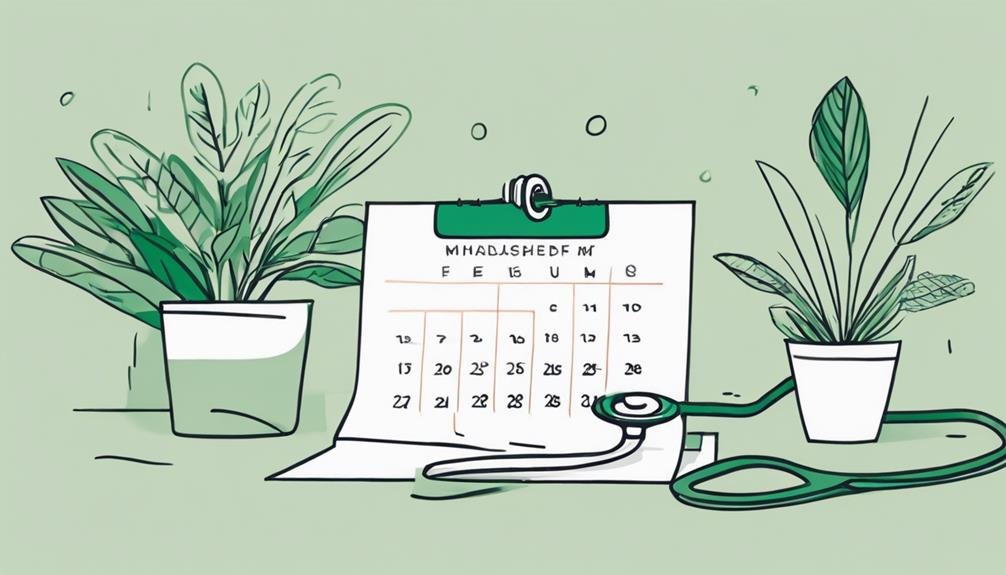10 Essential Fitness Tips for Men Over 40
As a man over 40, it's crucial to prioritize your health with these essential fitness tips. Start by engaging in at least 150 minutes of aerobic exercise weekly and incorporate strength training twice a week. Don't overlook flexibility; stretching regularly can prevent injuries. Set realistic goals that motivate you, and monitor your nutrition by focusing on nutrient-rich foods. Hydration is key, so drink plenty of water. Schedule regular health check-ups to stay on top of any issues, and consider finding a workout buddy for encouragement. Listening to your body and adding active recovery days will boost your overall well-being. You'll discover even more ways to thrive!
Key Takeaways
- Engage in at least 150 minutes of aerobic exercise weekly to boost cardiovascular health and reduce chronic disease risk.
- Include strength training sessions focusing on major muscle groups at least twice a week to maintain muscle mass.
- Incorporate flexibility exercises like yoga and dynamic stretches 3-4 times a week to enhance mobility and prevent injuries.
- Monitor your nutritional intake, emphasizing lean proteins, whole grains, and fruits, while reducing processed foods and added sugars.
Prioritize Cardiovascular Health
To maintain your energy, you should prioritize cardiovascular health through regular aerobic exercise and a heart-healthy diet. Engaging in activities like brisk walking, cycling, or swimming for at least 150 minutes a week can greatly boost your heart health. Not only will these exercises improve your stamina, but they'll also help reduce the risk of chronic diseases.
Incorporate nutrient-dense foods, such as fruits, vegetables, whole grains, and lean proteins, into your meals. These foods provide essential vitamins and minerals while promoting a healthy weight.
Limit your intake of saturated fats, sugars, and sodium to keep your heart in ideal shape. Remember, consistent effort in these areas can lead to a healthier, more energetic lifestyle as you age.
Incorporate Strength Training
Incorporating strength training into your routine is crucial for maintaining muscle mass and overall fitness as you age. It helps counteract the natural decline in muscle and bone density that occurs after 40.
Aim for at least two sessions a week, focusing on major muscle groups like legs, back, and chest. You don't need fancy equipment; bodyweight exercises, resistance bands, or free weights can be effective.
Start with lighter weights and gradually increase resistance to avoid injury. Consistency is key, so schedule your workouts just like any other important appointment.
Don't forget to allow for recovery time between sessions to let your muscles repair and grow stronger. By making strength training a priority, you'll enhance your liveliness and improve your quality of life.
Focus on Flexibility

While strength training builds muscle, focusing on flexibility is equally important for preventing injury and maintaining mobility as you age. Incorporating flexibility exercises into your routine can enhance your overall performance and reduce the risk of strains. Stretching regularly, whether through yoga or dynamic stretches, helps keep your muscles long and joints healthy.
Here's a quick reference for some flexibility exercises you might consider:
| Exercise | Duration (seconds) | Frequency (per week) |
|---|---|---|
| Hamstring Stretch | 30 | 3-4 |
| Shoulder Stretch | 30 | 3-4 |
| Quadriceps Stretch | 30 | 3-4 |
| Cat-Cow Stretch | 30 | 3-4 |
| Seated Forward Bend | 30 | 3-4 |
Make flexibility a priority in your fitness regimen!
Set Realistic Goals
Setting realistic goals is essential for staying motivated and making progress in your fitness journey after 40.
Start by evaluating your current fitness level and define what you want to achieve. Instead of aiming for drastic weight loss or extreme muscle gain, focus on smaller, achievable targets.
For instance, commit to exercising three times a week or increasing your daily step count by 1,000. Break larger goals into manageable milestones to celebrate your successes along the way.
Remember, progress takes time, and setbacks are normal. Adjust your goals as needed, but always keep them attainable.
Monitor Nutritional Intake

Monitoring your nutritional intake is essential for maintaining energy levels and supporting your fitness goals as you age. As you enter your 40s, your body's metabolism changes, making it crucial to pay attention to what you eat.
Focus on consuming lean proteins, whole grains, healthy fats, and plenty of fruits and vegetables. These foods provide the necessary nutrients to fuel your workouts and aid recovery.
Keep track of your daily caloric intake and adjust portions based on your activity level. Consider reducing processed foods and added sugars, which can lead to unwanted weight gain.
Stay Hydrated
Staying hydrated is just as important as watching your nutritional intake, especially for men over 40 who need to maintain ideal energy levels and support their workouts.
As you age, your body's water content decreases, making it essential to drink enough fluids daily. Aim for at least 8-10 cups of water, adjusting based on activity levels and climate.
Don't wait until you're thirsty; make hydration a habit. Carry a reusable water bottle, and sip throughout the day.
Include hydrating foods like fruits and vegetables in your diet, too. Not only will proper hydration enhance your performance, but it'll also aid recovery and overall health.
Schedule Regular Check-ups

Scheduling regular check-ups is essential for maintaining your health and catching potential issues early as you age.
As you hit your 40s, your body undergoes changes that might require closer monitoring. Regular visits to your healthcare provider can help you stay on top of vital health metrics, such as blood pressure, cholesterol levels, and blood sugar.
These check-ups are also an opportunity to discuss any concerns you have, from joint pain to sleep issues.
Don't forget to get recommended screenings, like prostate exams or colonoscopies, tailored to your age and risk factors.
Find a Workout Buddy
Finding a workout buddy can greatly boost your motivation and keep you accountable on your fitness journey. Having someone to share your goals with makes the process more enjoyable and less intimidating. Plus, you can push each other to reach new heights.
| Benefit | Explanation |
|---|---|
| Accountability | You're less likely to skip workouts with a partner. |
| Motivation | A buddy can encourage you when you feel like giving up. |
| Social Interaction | Workouts become more fun and engaging. |
| Variety | You can try new activities together. |
| Safety | Having a partner can help prevent injuries. |
Listen to Your Body

Listening to your body is essential for avoiding injuries and ensuring long-term success in your fitness routine.
As you age, it's important to recognize the signals your body sends you. If you feel pain, fatigue, or discomfort, don't push through; adjust your workout accordingly. That might mean lowering the intensity, taking extra rest days, or even skipping certain exercises altogether.
Remember, there's a fine line between challenging yourself and overdoing it. Pay attention to your energy levels and recovery times, and don't hesitate to consult a fitness professional if you're unsure about any symptoms.
Embrace Active Recovery
Incorporating active recovery into your routine can greatly enhance your overall fitness and help prevent burnout. Instead of spending your rest days on the couch, consider low-intensity activities like walking, swimming, or yoga.
These exercises keep your blood flowing, aiding muscle recovery while still allowing your body to rest. You'll notice improved flexibility, reduced soreness, and increased energy levels when you engage in active recovery.
Aim for 20 to 30 minutes a few times a week, focusing on movements that feel good to you. Remember, this isn't about pushing hard; it's about listening to your body and allowing it to recuperate.
Questions
What Types of Exercises Are Best for Joint Health After 40?
To maintain joint health after 40, focus on low-impact exercises like swimming, cycling, or yoga. These activities strengthen muscles, improve flexibility, and reduce stress on your joints, helping you stay active and pain-free.
How Can I Boost My Metabolism as I Age?
Think of your metabolism as a fire that needs fuel. To boost it, incorporate strength training, eat protein-rich foods, stay active throughout the day, and hydrate. These steps keep your metabolic flames burning bright.
Is It Safe to Start a New Workout Routine at 40?
Yes, it's safe to start a new workout routine at 40, as long as you listen to your body and consult a doctor if needed. Gradually increase intensity, and focus on proper form to avoid injuries.
What Supplements Should Men Over 40 Consider for Fitness?
Consider supplements like vitamin D, omega-3 fatty acids, and protein powder. They help support muscle recovery, joint health, and overall energy levels. Always consult a healthcare professional before starting any new supplement regimen.
How Do I Prevent Injuries While Exercising at This Age?
To prevent injuries while exercising, you should warm up properly, listen to your body, and use correct form. Gradually increase intensity, incorporate rest days, and stay hydrated for ideal recovery and performance.
Conclusion
As you embrace these essential fitness tips, remember that your body is a finely tuned instrument; treat it with care and respect.
Prioritizing cardiovascular health, strength training, and flexibility will keep you in harmony with your goals.
Set realistic targets, monitor your nutrition, and don't hesitate to seek support from a workout buddy.
By listening to your body and allowing for active recovery, you'll not only enhance your fitness but also enrich your overall quality of life.







